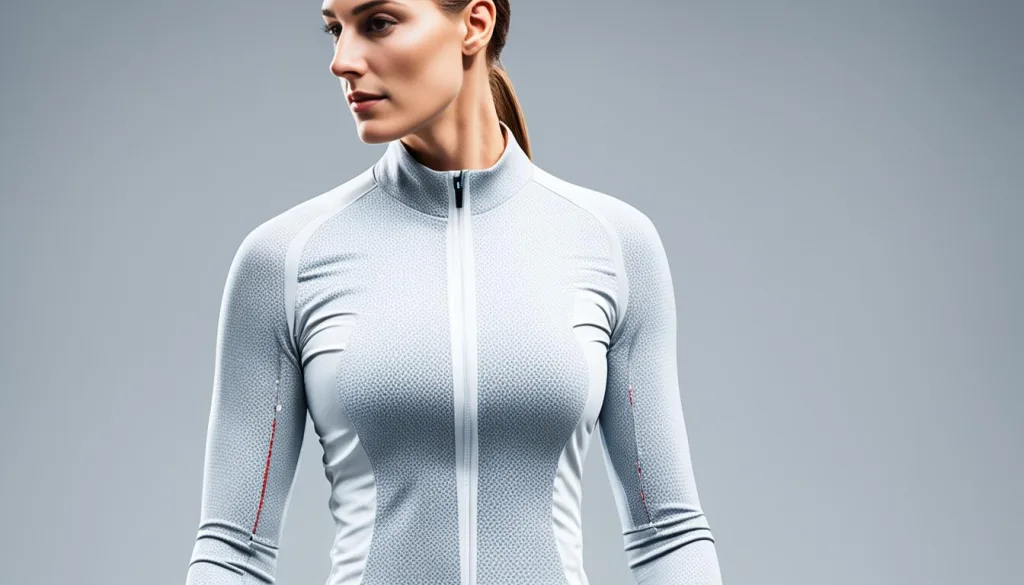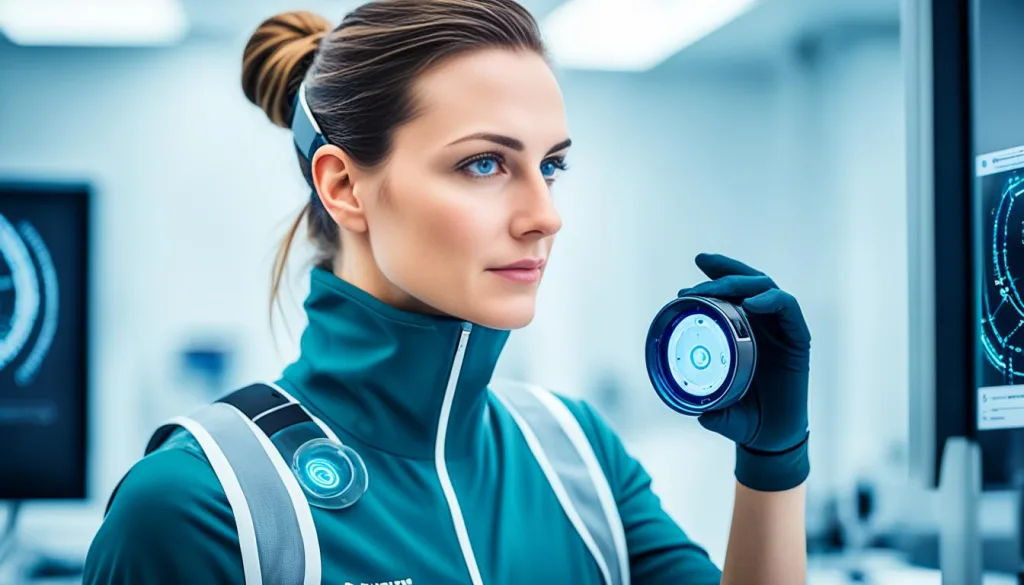Developing Smell-Sensing Technologies in Apparel for Health Diagnostics
Connect With Us Today
Consider us for your next production run. Why wait? Send us your questions here.
The rise of smell-sensing clothes is changing the game in health checks, making it a simple part of daily life. These clever garments use breath tests that are easy and painless for people everywhere1. They examine the gases we release through our skin and breathing2.
This helps track possible illnesses very well1. As these gadgets become more focused on the wearer, they provide updates on health stats right away2. Smell-sensing clothes are leading the way into a new age where preventing sickness and tailoring treatments is key.
Key Takeaways
- Smell-sensing apparel merges wearable technology with health diagnostics for non-invasive monitoring
- Digital olfaction harnesses breath analysis to detect diseases1 and track health indicators2
- The technology advances personalized patient care, enabling early detection and treatment response
- Apparel-embedded sensors represent the future of preventative healthcare solutions
- Current research from across the globe is strengthening the foundation of scent-based diagnostics1
The Current Landscape of Digital Olfaction Technology
Digital olfaction technology is the merging of tech with our basic sense of smell. It uses advanced tech to recreate our ability to recognize different odors. These technologies are not just for health diagnostics but also boost business success and consumer enjoyment. AI and machine learning play a big role in improving these devices, making them smarter over time.
Understanding the Basics of Digital Smell Technology
The science behind digital smell is complex. It involves organic chemistry, engineering, and data analysis. In France, Aryballe uses peptides on silicon to make sensors that detect specific odors3. Over in California, Aromyx applies human smell receptors to identify various aromas. This could change how industries handle smell detection3.
Commercial Importance and Retail Applications of Olfaction Technology
Digital smell tech has seen great success in retail. It shows that scents can really make shopping more enjoyable. A study with a Nike store showed that scents boosted happiness, spending, and return visits3. It highlights how important scent is in transforming retail spaces.
The Role of AI and Machine Learning in Advanced Odor Detection
AI and machine learning are key in understanding odor detection better. These technologies allow smell devices to identify and get used to new scents over time. The future of digital smell tech relies on AI to provide personalized experiences and precise uses in various industries.
There’s a strong link between smell tech and human psychology. Smell plays a big part in survival, memories, and emotions4. Our emotional brain center, the limbic system, is affected by smells. This connection is vital in digital smell tech. Also, our ability to tell apart smells can get better, showing how machine learning can improve digital smell tech4.
| Technological Application | Study Focus | Statistical Insight |
|---|---|---|
| Biosensors in Health Diagnostics | Electronic-nose technologies use | 64% of articles5 |
| Biomimetic Sensors | Olfactory receptor proteins readout | 1 in 5 studies5 |
| Disease Diagnosis | Nanovesicle-based bioelectronic noses | 32% of studies5 |
Today, digital olfaction tech is going through a period of rapid growth. Companies and inventors are diving deep into this field. They combine various scientific areas to create a future where scents trigger memories and feelings. They also play a major role in businesses, health diagnostics, and understanding our senses.
Developing Smell-Sensing Technologies in Apparel for Health Diagnostics
Health diagnostics are changing thanks to smell-sensing tech in our clothes. It’s valued for being easy to use and noninvasive. These smart clothes check our health by analyzing body odor. This way, they quickly tell us about our health, helping catch diseases early.
Innovative Startups Pioneering Smell-Sensing Apparel
Innovative companies are making clothes that could save lives. They use Na-Nose technology, which can diagnose diseases with 86% accuracy1. This tech is especially good at spotting certain illnesses, like gastric cancer1. Its precision has caught the attention of several companies for further development1.
People like that these clothes check health without being invasive1. Startups from all over, including Spain and the US, are working hard on this tech1.

Integration of E-Textiles and Wearables in Health Monitoring
E-textiles blend digital tech with fabrics for health care. They help spot health issues, like prostate cancer, through breath. This could make healthcare cheaper and less invasive. Yet, telling apart body and environmental odors remains tricky1.
Creating accurate health profiles with this tech means considering many factors. Diet and actions like mouth rinsing affect the tests. So, refining these wearables and their sensors is crucial1.
Portable monitors and advancements are pushing breath analysis forward. But, it’s still a new area with room to grow. Startups are working hard to make e-textiles key for health checks.
Combining clothes with health checks points to a future where our wear is both stylish and protective. There’s a big chance for the world to adopt these health-monitoring clothes. They could change how we handle healthcare and disease prevention.
Prospects of Smell-Sensing Tech in Medical Diagnostics
The growth of smell-sensing tech is changing medical diagnostics. It’s carving a path for non-invasive disease detection and health monitoring. Masoud Agah and his team got nearly $400,000 from the National Science Foundation. They’re working on devices like the SenSorp skin scent sampler6. These devices can detect complex biological information from volatile organic compounds found in the skin6.
Non-Invasive Disease Detection Through Volatile Organic Compounds
Our skin holds over 500 detectable compounds, including aldehydes and ketones6. This opens up big possibilities for spotting diseases without surgeries. Experts from Ireland help by creating gas sensors and skin sensors6. Their work supports making tools that can change how we diagnose diseases.
SenSorp aims to make health diagnostics easy and non-invasive, like the home COVID tests. They use semiconductor patches to analyze skin odor quickly6. This method could offer health insights during your day-to-day activities. It shows the future of wearable medical devices, expected to reach $196 billion by 20306.
The Impact of E-Nose Technology on Early Lung Cancer Screening
E-nose tech could revolutionize lung cancer screening by identifying disease-specific smells. This is key for early detection and improving survival rates. As this technology evolves, its role in reducing sickness and healthcare costs will grow.
The mix of healthcare and tech brings smell-sensing devices into everyday use. Wearable patches for disease detection integrate smoothly into daily life. They mark a new phase in painless health monitoring and personal care. E-nose technology could make lung cancer screening simpler and more effective.
Expanding Applications of Smell-Sensing Apparel
The way we make clothes is changing, thanks to new sensor technologies. Now, our outfits can tell us about our health and wellness. There’s a growing demand for gadgets that are easy to carry and can check our health in innovative ways. With smell-sensing clothes, which pick up biomarkers in respiration, we’re seeing a smart blend of tech and fashion. This blend is perfect for tracking our well-being and making early health choices2.

Advancements in Sensor Technologies and Portable Devices
Recently, sensor tech has made big leaps, giving us portable devices that fit right into our clothes. They check our exhaled breath, which has many different elements like nitrogen and oxygen. The cool part is, these sensors are easy to use, practical, and accurately assess health. They’re safe, long-lasting, and stay accurate even with small bumps or movements2.
Market Growth and Future Potentials in Health and Wellness Sector
The health and wellness world is getting more tech-savvy, which means smell-sensing clothes are becoming more popular and varied in use. These clothes make testing easy and comfy because they monitor our breathing without bothering us2. This opens up new possibilities for diagnosing health issues and more. As people pay more attention to preventing illness, these wearable techs become key in improving health, sports performance, and monitoring the environment.
| Component | Concentration in Exhaled Breath | Importance in Wearable Healthcare |
|---|---|---|
| Nitric oxide, ammonia, CO | ppb concentrations | Biomarkers for noninvasive health monitoring |
| Acetone, Ethanol, Isoprene | ppm concentrations | |
| Methane, Pentane | Varies |
Challenges and Ethical Considerations in Smell-Sensing Tech
Bringing smell-sensing technology into daily life presents ethical challenges and practical hurdles. We must ensure people’s privacy and data security in this new field. It’s vital to protect the sensitive information from olfactory sensors for both moral and technical reasons. Doing so respects individuals’ privacy while exploring the benefits of digital smell technology.
Addressing Privacy Concerns and Data Security
Smell-sensing tech has moved from labs to industries, affecting customers. For example, scents in a Nike showroom can make people more likely to return3. But, this raises issues about privacy and handling sensitive smell data. We must take these concerns seriously and ensure data protection against leaks or misuse.
Ensuring Accuracy and Reliability in Health Diagnostics
For health diagnostics, smell-sensing tech must be accurate and reliable. Companies are using peptides and receptors to identify smells3. Yet, it’s tough to get consistent results due to varying conditions and personal differences. We must ensure these tools are always accurate and dependable for every patient.
We must tackle these challenges together. Innovators, regulators, and stakeholders need to ensure smell-sensing tech uses ethical practices. There should be strong privacy policies and a commitment to protect users’ data.
Conclusion
Looking ahead, smell-sensing clothes could change health care by mixing it into our day-to-day lives. This tech, powered by digital smelling abilities, might shift how we do health checks. It pushes for care that’s both proactive and tailored to each person.
The development of these techs shows they’re more than just a new tool. They’re leading the way to track health without being invasive. They can tell a lot about our health by analyzing the air we carry around. This could make finding diseases early easier than ever. Plus, these clothes could do more, like help us stay well and keep an eye on the environment.
Yet, it’s important to tackle the tech’s challenges and ethical issues. This includes handling privacy concerns and ensuring the tech is accurate and reliable. As these smell-sensing devices become part of our lives, keeping high standards is key. By blending innovation with responsibility, we’re entering a hopeful time for both makers and users in health and wellness.
FAQ
What are smell-sensing technologies in apparel?
How do smell-sensing technologies work?
What are the prospects of smell-sensing technology in medical diagnostics?
How can smell-sensing apparel benefit personal wellness and sports performance monitoring?
What challenges and ethical considerations are associated with smell-sensing technology?
Source Links
- https://www.cnn.com/2017/11/07/health/na-nose-disease-smell-technology/index.html
- https://www.nature.com/articles/s41427-023-00513-9
- https://sloanreview.mit.edu/article/business-scents-the-rise-of-digital-olfaction/
- https://www.mdpi.com/2414-4088/6/7/57
- https://www.ncbi.nlm.nih.gov/pmc/articles/PMC7146165/
- https://news.vt.edu/articles/2022/11/Beauty-is-only-skin-deep-it-turns-out-so-is-disease-detection-agah-nsf-skin-sensor.html
Latest News
How Collaboration Shapes Consumer Preferences in Sportswear
Navigating Consumer Rights and Warranties in Sportswear Sales
Artificial Intelligence in Fashion Forecasting and Trend Analysis
The Shift Towards Inclusive Sizing in Sportswear: Consumer Reactions
The Global Expansion of Luxury Sportswear Brands
From Sketch to Gym: The Design Process of Fashionable Sportswear
Understanding the Role of Trade Associations in Sportswear Compliance
How Economic Trends Influence Consumer Spending on Sportswear
Learning from Successful Global Market Entries
Best Practices for Managing Cross-Cultural Teams
Using Technology to Fight Counterfeit Fashion Products
Carbon Nanotube Fabrics for Superior Strength and Flexibility
The Growth of Fitness Tracking Apparel in Health and Wellness
Exploring the Influence of Social Proof in Sportswear Purchasing
Strategies for Managing Compliance in a Multinational Operation
Trends in Global Footwear: Performance Meets Lifestyle
The Role of Artificial Intelligence in Tracking Supply Chain Operations
Evaluating the Success of Sportswear Collaborative Projects
Evaluating the Potential of Emerging Markets
Global Shifts Towards Gender-Neutral Sportswear
Share This Article
Latest Articles



















